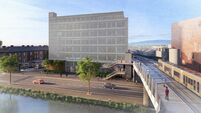Limerick families angry after just 76 out of 7,000 regeneration houses built
The plan launched in 2008 carried a price tag of over €3bn with the aim, over 10 years, of replacing and rebuilding over 7,000 houses in four estates— Southill, Ballinacurra Weston, St Mary’s Park and Moyross. But six years on, just 76 houses have been completed.
It has been a programme more of relocation than regeneration with up to 400 families moved to other parts of the city and surrounding areas.













